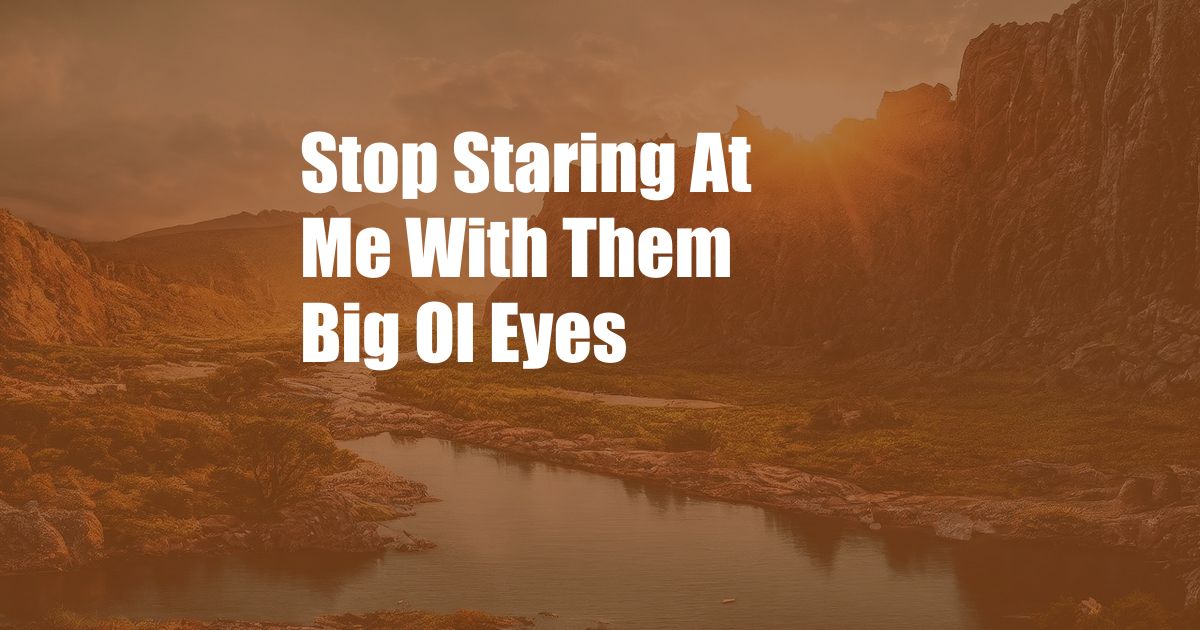
Stop Staring at Me With Them Big Ol’ Eyes
Have you ever been in a situation where you felt someone’s gaze upon you, making you feel uncomfortable and self-conscious? It’s a common experience that many of us have gone through at some point in our lives. In this article, we’ll delve into the topic of staring and explore its psychological impact, cultural significance, and how to deal with it effectively.
Staring, also known as gaze or eye contact, is a form of nonverbal communication. It can convey various emotions and intentions, depending on the context and social norms. While brief eye contact is often considered polite and respectful, prolonged staring can make people feel uneasy, intimidated, or even threatened.
The Psychology of Staring
From a psychological perspective, staring can be seen as a way of asserting dominance or power over someone. It can also be a sign of attraction, curiosity, or fear. In some cases, individuals with autism spectrum disorder (ASD) or social anxiety disorder (SAD) may engage in staring as a way of coping with social interactions.
When someone stares at us, it can trigger our fight-or-flight response, making us feel defensive or anxious. This is because staring can be perceived as a threat to our personal space and safety. In certain cultures, staring is considered rude and disrespectful, while in others, it may be seen as a form of compliment. Understanding the cultural context of staring is important for interpreting its meaning
Dealing With Staring
If you find yourself being stared at, there are several ways to handle the situation:
- Maintain eye contact: Holding the other person’s gaze can sometimes make them break eye contact. However, it’s important to avoid staring back aggressively, as this could escalate the situation.
- Use body language: Nonverbal cues, such as crossing your arms or turning away, can signal to the other person that you’re uncomfortable with their staring.
- Speak up: If the staring persists, you can politely ask the person to stop. Be clear and direct, but try to remain calm and respectful.
- Move away: If the other person doesn’t stop staring, you may need to physically move away from them. This can be a good option if you feel threatened or uncomfortable.
Tips for Avoiding Staring
If you find yourself unintentionally staring at others, here are some tips to avoid making them feel uncomfortable:
- Be aware of your gaze: Pay attention to how long you’re looking at someone. If you notice yourself staring, break eye contact and look away.
- Respect personal space: Be mindful of how close you’re standing to others. Intimate eye contact is appropriate in close relationships but may be perceived as invasive in public settings.
- Avoid staring at vulnerable individuals: Individuals with ASD or SAD may be more sensitive to staring. Be respectful of their boundaries and avoid prolonged eye contact.
Common Questions About Staring
Q: Why do people stare?
A: People stare for various reasons, including curiosity, attraction, power assertion, or social anxiety.
Q: Is it rude to stare?
A: Yes, in many cultures, prolonged staring is considered impolite and disrespectful.
Q: What should I do if someone is staring at me?
A: Maintain eye contact, use body language to signal your discomfort, or politely ask the person to stop staring.
Conclusion
Staring is a complex and intriguing aspect of human behavior. Understanding its psychological impact and cultural significance can help us navigate social interactions more effectively. Whether we’re dealing with unwanted stares or aiming to avoid making others feel uncomfortable, practicing empathy, respect, and clear communication can create a more positive and inclusive environment for everyone.
If you have any further questions or experiences related to staring, we encourage you to engage with the discussion in the comments section below. Your insights and perspectives can add valuable contributions to our understanding of this topic.